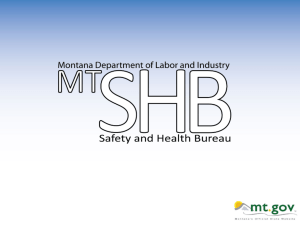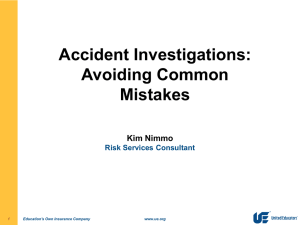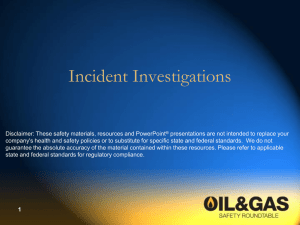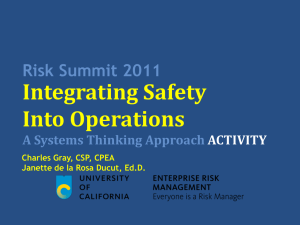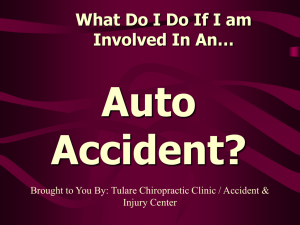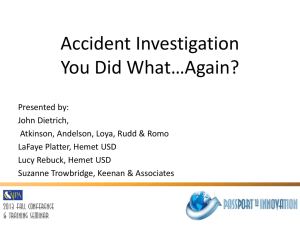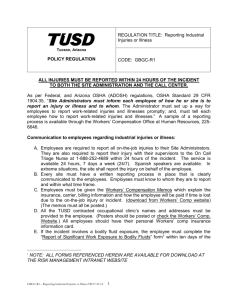Supervisor Injury Response - Summit County Safety Council
advertisement
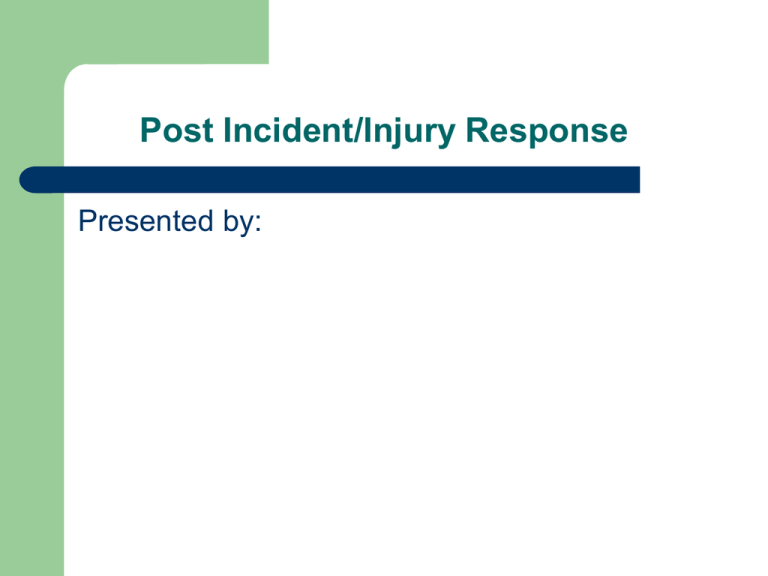
Post Incident/Injury Response Presented by: Purpose To ensure management/supervision responds appropriately and with confidence in the event of an incident. Learning Objective At the conclusion of this training you will be able to: Follow appropriate steps following an injury Minimize the chance for future injuries Additionally you will : – – – Establish relevant facts as to the how and why an incident occurred Determine the root cause of any incident Draw conclusions to what must be done to prevent reoccurrence Definition Incident- General term used to refer to any work related injury, medical emergency, or near miss LTA (Lost Time Accident) – An injury that causes an employee to miss his/her next scheduled shift Medical Emergency- A sudden illness that occurs to a person that is not work related (heart attack, diabetic emergency) Definition Continued Near Miss Accident – A hazardous and undesirable event that does not cause injury ORA (OSHA Recordable Accident) – Any injury that requires medical treatment, as defined by OSHA (stitches, prescription for medication) Work-Related Injury – An injury that occurs at work Near Misses Complete Accident Investigation Report Investigate and document as if an injury happened Initial Response to Incident Show genuine concern for the well-being of the person Determine the severity of the illness or injury Contact the Safety and Environmental Department or First Responder if necessary Determining Severity of Emergency Does the person appear to need medical treatment? Does the person want to seek medical treatment? Injury and Incident Forms Nurse’s office Safety Coordinators office If Medical Treatment is not required or desired Employee completes an Injury Report immediately Witnesses complete an Injury Report Witness Statement Immediately Superintendent Completes an Accident Investigation Report within 24 hours Original report is sent to Nurse Medical Emergencies Requiring Medical Treatment (non-work related) Contact the Safety and Environmental Department on 1st Shift Contact a First Responder on 2nd and 3rd Shift If you are unsure if Medical Treatment is necessary contact Safety and Environmental on the emergency numbers Drug and Alcohol Screen is not required since it is not work related Transportation to medical facility is by EMS or Family member only Work Related Injury Requiring Medical Treatment Employee completes an Injury Report immediately if appropriate at the time Any witnesses complete an Injury Report Witness Statement immediately Superintendent completes an Accident Investigation Report within 24 hours Employee must complete an Alcohol and Drug Screen at the time of medical treatment Transportation to Preferred Provider for Work Related Injuries 1. 2. 3. Public EMS will take a person with severe injuries Private Ambulance or Taxi will take a person with less severe injuries Family Member may take a person with a non-work related illness or injury NOTE: Employees may not transport injured or ill workers Investigation Why do we do investigations? To Prevent anyone else from being injured. Investigation All injuries and near misses are to be investigated by the Superintendent This includes completion of Accident Investigation Report and requires appropriate investigation The investigation is conducted without delay to prevent reoccurrence Accident and near miss investigations are fact finding, not fault finding Investigations Document everything Isolate the scene (i.e. LOTO) Collect only the facts Interview all witnesses and bystanders Recreate events and document Fix simple issues (i.e. Poor Housekeeping) Maintenance work order (include with report) Gather Information 1. 2. 3. 4. 5. 6. Assemble a Team of cross functional workgroups if necessary Interviewing the injured employee as primary source of information Interviewing witnesses to the incident or near miss to determine critical factors Assessing the accident scene by interviewing employee at the scene Re-enactment of the accident to review circumstances to get a more precise picture Reconstruction of the accident by means of controlled imagination applied to clue Root Cause All injuries and incidences can be prevented. It is important to determine the root cause of an incident The root cause of all near miss or first aid injuries must be properly investigated and corrected to reduce the potential of the incidents reoccurring as a disabling injury Most injuries can be traced back to an unsafe act of a worker Injury Prevention Determine ways to prevent a reoccurrence Implement action on a prevention plan Communicate any improvements, repairs or changes to Employees Conduct follow-up to ensure prevention plan was implemented and continues to be implemented Show concern for the well being of your employees Get phone number to call and inform relative Follow up call to injured employee next day Communicate any resulting repairs or work modifications to all employees Forklift Incident Remove the person from Forklift until retrained Inform Safety Coordinators of retraining Discipline: Come forward vs hide Drug and Alcohol screen for damage Reward vs. Discipline Tactful approach Care enough about employees that you will discipline them so they don’t hurt themselves or others Reward simple safety items Superintendant Responsibility If you must discipline: Don’t tell them its because safety said so, your boss is making you or those are the rules. Tell them you are concerned for their wellbeing and you don’t want to see them get hurt. Proactive Injury Prevention “Everyone knows this doesn’t work” “Everyone knows that this is a problem” “Everyone knows that hasn’t worked for a while” “You know what you need to do for safety” If someone brings you a safety issue, ask them if they have a solution to the issue. Conclusion Respond to emergencies with confidence Complete thorough investigation following a near miss or injury Complete and submit necessary forms Encourage Employees to take responsibility for their well being (They are responsible for their own injury) Injuries do not just happen to people without their control Push for our goal of zero incidences and injuries

